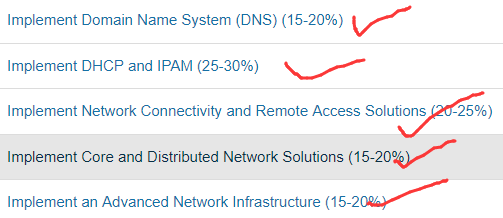Get Real Windows Server 2016 70-741 Questions To Pass 70-741 Exam
How to pass Microsoft 70-741 Networking with Windows Server 2016 exam? Now, you can get real Windows Server 2016 70-741 questions to pass Microsoft 70-741 exam in the first try. According to the latest reviews, PassQuestion 70-741 exam questions have been verified by more than 10 customers who have passed their 70-741 exam. They practiced all PassQuestion 70-741 exam questions and answers carefully and finally, they all passed 70-741 Networking with Windows Server 2016 exam successfully, with high scores. Real Windows Server 2016 70-741 questions come with real exam questions and accurate answers, which ensure that you can pass Microsoft MCSA Windows Server 2016 70-741 exam in the first try.

MCSA Windows Server 2016 Certification Exams (70-740, 70-741, 70-742)
Microsoft 70-741 Networking with Windows Server 2016 is one of three exams for MCSA Windows Server 2016 Certification. MCSA Windows Server 2016 certification mainly prove your mastery of the primary set of Windows Server 2016 skills required to reduce IT costs and deliver more business value. You are required to pass three exams as listed:
70-740 Installation, Storage, and Compute with Windows Server 2016
70-740 exam focuses primarily on the installation, storage, and compute features and functionality available in Windows Server 2016.
70-741 Networking with Windows Server 2016
Microsoft 70-741 exam focuses on the networking features and functionality available in Windows Server 2016.
70-742 Identity with Windows Server 2016
70-742 exam focuses on the identity functionality in Windows Server 2016.
Additionally, there are three other exams for Windows Server 2016 certification.
70-743 Upgrading Your Skills to MCSA: Windows Server 2016
Candidates who have already earned an MCSA: Windows Server 2008 or MCSA: Windows Server 2012 R2 certification can take 70-743 Upgrading Your Skills to MCSA: Windows Server 2016 to get MCSA:Windows Server 2016 certification. Candidates for Microsoft 70-743 exam are IT professionals who implement the Windows Server 2016 core infrastructure services.
70-744 Securing Windows Server 2016
Microsoft 70-744 exam help candidates secure Windows Server 2016 environments.
70-745 Implementing a Software-Defined Datacenter
Microsoft 70-745 exam is targeted towards data management professionals, data architects, data scientists, and data developers who design big data analytics solutions on Microsoft Azure. Candidates for this exam will have relevant work experience in big data analytics solutions.

Not only real Windows Server 2016 70-741 questions, we also offer valid 70-740 exam questions, 70-742 study guide, 70-743 test questions, 70-744 study materials and 70-745 practice questions. You can come to PassQuestion to choose the great preparation materials for well-prepared.
Networking with Windows Server 2016 Exam 70-741
When take 70-741 Networking with Windows Server 2016 exam, candidates should have related skills and knowledge:
· Candidates should have familiarity with implementing and managing DNS, DHCP, and IPAM, as well as deploying remote access solutions such as VPN and RADIUS.
· Candidates should have experience managing DFS and branch cache solutions, configuring high performance network features and functionality, and implementing Software Defined Networking (SDN) solutions such as Hyper-V Network Virtualization (HNV) and Network Controller.
70-741 exam measures your ability to accomplish the technical tasks listed below:

Get Real Windows Server 2016 70-741 Questions To Pass 70-741 Exam
The finally step to prepare for 70-741 Networking with Windows Server 2016 Exam is get real Windows Server 2016 70-741 questions to pass 70-741 exam smoothly. PassQuestion offers Real Windows Server 2016 70-741 Questions that is suitable for your preparation of the Microsoft 70-741 exam to pass in your first attempt with high scores.
Read Free 70-741 Questions V15.02 Online First
You have a virtual machine named VM1 that runs Windows Server 2016, VM1 hosts a service that requires high network throughput.
VM1 has a virtual network adapter that connects to a Hyper-V switch named vSwitch1. vSwitch1 has one network adapter. The network adapter supports Remote Direct Memory Access (RDMA), the single root I/O virtualization (SR-IOV) interface, Quality of Service? (QoS), and Receive Side Scaling (RSS).
You need to ensure that the traffic from VM1 can be processed by multiple networking processors.
Which Windows PowerShell command should you run on the host of VM1?
A. Set-NetAdapterRss
B. Set-NetAdapterRdma
C. Set-NetAdapterQos
D. Set-NetAdapterSriov
Answer: A
Your network contains an Active directory forest named contoso.com. The forest has a Distributed File System (DFS) namespace named \\contoso.com\namespace1.
The domain contains a file server named Server1 that runs Windows Server 2016.
You create a folder named Folder1 on Server1.
You need to use Folder1 as a target for Namespace1.
Which two cmdlets should you use? Each correct answer presents part of the solution.
NOTE: Each correct selection is worth one point.
A. New-DfsnFolderTarget
B. Install-WindowsFeature
C. Grant-DfsnAccess
D. New-DfsnFolder
E. New-SmbShare
Answer: A,C
You have servers named Server1 and DHCP1. Both servers run Windows Server 2016. DHCP1 contains an IPv4 scope named Scope1.
You have 1,000 client computers. You need to configure Server1 to lease IP addresses for Scope1. The solution must ensure that Server1 is used to respond to up to 30 percent of the DHCP client requests only.
You install the DHCP Server server role on Server1.
What should you do next?
A. From the DHCP console, run the Configure Failover wizard.
B. From Server Manager, install the Network Load Balancing feature.
C. From Server Manager, install the Failover Clustering feature.
D. From the DHCP console, create a superscope.
Answer: A
You have a server named Server1 that runs Windows Server 2016.
Server1 has two network cards. One network card connects to your internal network and the other network card connects to the Internet. You plan to use Server1 to provide Internet connectivity for client computers on the internal
network. You need to configure Server1 as a network address translation (NAT) server.
Which server role or role service should you install on Server1 first?
A. Network Controller
B. Web Application Proxy
C. Routing
D. DirectAccess and VPN (RAS)
Answer: C
You have multiple servers that run Windows Server 2016 and are configured as VPN servers. You deploy a server named NPS1 that has Network Policy Server (NPS) installed. You need to configure NPS1 to accept authentication requests from the VPN servers.
What should you configure on NPS1?
A. From RADIUS Clients and Servers, add a remote RADIUS server group.
B. From Policies, add a connection request policy.
C. From Policies, add a network policy.
D. From RADIUS Clients and Servers, add RADIUS clients.
Answer: D
You are deploying a small network that has 30 client computers. The network uses the 192.168.1.0/24 address space. All computers obtain IP configurations from a DHCP server named Server1.
You install a server named Server2 that runs Windows Server 2016. Server2 has two network adapters named internal and Internet. Internet connects to an Internet service provider (ISP) and obtains the 131.107.0.10 IP address. Internal connects to the internal network and is configured to use the 192.168.1.250 IP address.
You need to provide Internet connectivity for the client computers.
What should you do?
A. On Server2, select the Internet and Internal network adapters and bridge the connections. From the DHCP console on Server1, authorize Server2.
B. On Server1, stop the DHCP server. On the Internal network adapter on Server 2, enable Internet Connection Sharing (ICS).
C. On Server2 run the New-NetNat –Name NAT1 -InternalIPInterfaceAddressPrefix 192.168.1.0/24 cmdlet. Configure Server1 to provide the 003 Router option of 131.107.0.10.
D. Install the Routing role service on Server2 and configure the NAT routing protocol. Configure Server1 to provide the 003 Router option of 192.168.1.250.
Answer: C
You are implementing a new network. The network contains a DHCP server named DHCP1 that runs Windows Server 2016. DHCP1 contains a scope named Scope1 for the 192.168.0/24 subnet.
Your company has the following policy for allocating IP addresses:
• All server addresses must be excluded from DHCP scopes.
• All client computer must receive IP addresses from Scope1.
• All Windows servers must have IP addresses in the range of 192.168.0.200 to 192.168.0.240
• All other network devices must have IP addresses in the range of 192.168.0.180 to 192.168.0.199.
You deploy a print device named Print1.
You need to ensure that Print1 adheres to the policy for allocating IP addresses.
Which command should you use?
A. Add-DhcpServerv4Lease
B. Add-DhcpServerv4ExclusionRange
C. Add-DhcpServerv4Filter
D. Add-DhcpServerv4Reservation
Answer: D
You have a DHCP server named Server1 that runs Windows Server 2016.
You have a single IP subnet.
Server1 has an IPv4 scope named Scope1. Scope1 has an IP address range of 10.0.1.10 to 10.0.1.200 and a length of 24 bits.
You need to create a second logical IP network on the subnet. The subnet will use an IP address range of 10.0.2.10 to 10.0.2.200 and a length of 24 bits.
What should you do?
A. Create a second scope, and then create a superscope.
B. Create a superscope, and then configure an exclusion range in Scope1.
C. Create a new scope, and then modify the IPv4 bindings.
D. Create a second scope, and then run the DHCP Split-Scope Configuration Wizard.
Answer: A
- TOP 50 Exam Questions
-
Exam
All copyrights reserved 2025 PassQuestion NETWORK CO.,LIMITED. All Rights Reserved.

